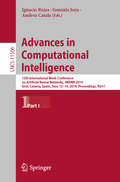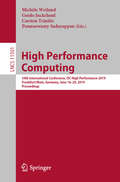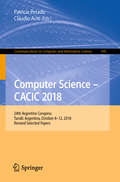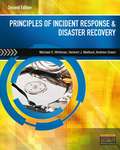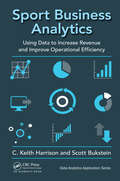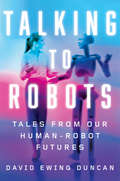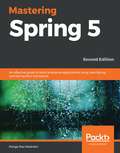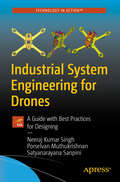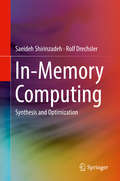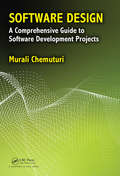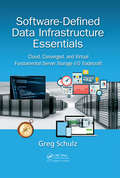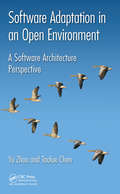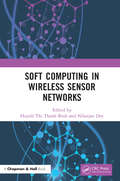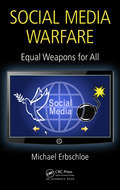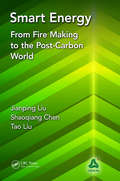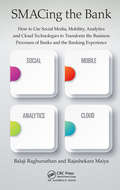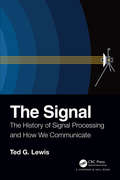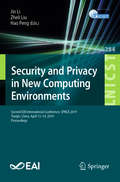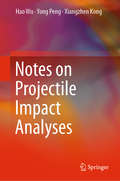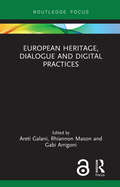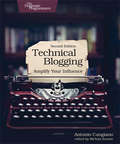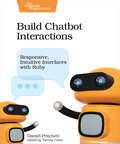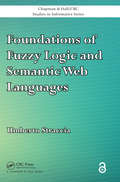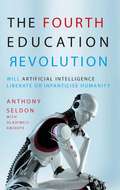- Table View
- List View
Advances in Computational Intelligence: 15th International Work-Conference on Artificial Neural Networks, IWANN 2019, Gran Canaria, Spain, June 12-14, 2019, Proceedings, Part I (Lecture Notes in Computer Science #11506)
by Ignacio Rojas Gonzalo Joya Andreu CatalaThis two-volume set LNCS 10305 and LNCS 10306 constitutes the refereed proceedings of the 15th International Work-Conference on Artificial Neural Networks, IWANN 2019, held at Gran Canaria, Spain, in June 2019.The 150 revised full papers presented in this two-volume set were carefully reviewed and selected from 210 submissions. The papers are organized in topical sections on machine learning in weather observation and forecasting; computational intelligence methods for time series; human activity recognition; new and future tendencies in brain-computer interface systems; random-weights neural networks; pattern recognition; deep learning and natural language processing; software testing and intelligent systems; data-driven intelligent transportation systems; deep learning models in healthcare and biomedicine; deep learning beyond convolution; artificial neural network for biomedical image processing; machine learning in vision and robotics; system identification, process control, and manufacturing; image and signal processing; soft computing; mathematics for neural networks; internet modeling, communication and networking; expert systems; evolutionary and genetic algorithms; advances in computational intelligence; computational biology and bioinformatics.
High Performance Computing: 34th International Conference, ISC High Performance 2019, Frankfurt/Main, Germany, June 16–20, 2019, Proceedings (Lecture Notes in Computer Science #11501)
by Guido Juckeland Michèle Weiland Carsten Trinitis Ponnuswamy SadayappanThis book constitutes the refereed proceedings of the 34th International Conference on High Performance Computing, ISC High Performance 2019, held in Frankfurt/Main, Germany, in June 2019.The 17 revised full papers presented were carefully reviewed and selected from 70 submissions. The papers cover a broad range of topics such as next-generation high performance components; exascale systems; extreme-scale applications; HPC and advanced environmental engineering projects; parallel ray tracing - visualization at its best; blockchain technology and cryptocurrency; parallel processing in life science; quantum computers/computing; what's new with cloud computing for HPC; parallel programming models for extreme-scale computing; workflow management; machine learning and big data analytics; and deep learning and HPC.
Computer Science – CACIC 2018: 24th Argentine Congress, Tandil, Argentina, October 8–12, 2018, Revised Selected Papers (Communications in Computer and Information Science #995)
by Patricia Pesado Claudio AcitiThis book constitutes revised selected papers from the 24th Argentine Congress on Computer Science, CACIC 2018, held in Tandil, Argentina, in October 2018. The 26 papers presented in this volume were carefully reviewed and selected from a total of 155 submissions. They were organized in topical sections named: Agents and Systems; Distributed and Parallel Processing; Technology Applied to Education; Graphic Computation, Images and Visualization; Software Engineering; Databases and Data Mining; Hardware Architectures, Networks, and Operating Systems; Innovation in Software Systems; Signal Processing and Real-Time Systems; Computer Security; Innovation in Computer Science Education; and Digital Governance and Smart Cities.
Principles Of Incident Response And Disaster Recovery
by Andrew Green Michael Whitman Herbert MattordPrinciples Of Incident Response And Disaster Recovery, 2nd Edition presents methods to identify vulnerabilities within computer networks and the countermeasures that mitigate risks and damage. From market-leading content on contingency planning, to effective techniques that minimize downtime in an emergency, to curbing losses after a breach, this text is the resource needed in case of a network intrusion.
Sport Business Analytics: Using Data to Increase Revenue and Improve Operational Efficiency (Data Analytics Applications)
by Scott Bukstein C. HarrisonDeveloping and implementing a systematic analytics strategy can result in a sustainable competitive advantage within the sport business industry. This timely and relevant book provides practical strategies to collect data and then convert that data into meaningful, value-added information and actionable insights. Its primary objective is to help sport business organizations utilize data-driven decision-making to generate optimal revenue from such areas as ticket sales and corporate partnerships. To that end, the book includes in-depth case studies from such leading sports organizations as the Orlando Magic, Tampa Bay Buccaneers, Duke University, and the Aspire Group. The core purpose of sport business analytics is to convert raw data into information that enables sport business professionals to make strategic business decisions that result in improved company financial performance and a measurable and sustainable competitive advantage. Readers will learn about the role of big data and analytics in: Ticket pricing Season ticket member retention Fan engagement Sponsorship valuation Customer relationship management Digital marketing Market research Data visualization. This book examines changes in the ticketing marketplace and spotlights innovative ticketing strategies used in various sport organizations. It shows how to engage fans with social media and digital analytics, presents techniques to analyze engagement and marketing strategies, and explains how to utilize analytics to leverage fan engagement to enhance revenue for sport organizations. Filled with insightful case studies, this book benefits both sports business professionals and students. The concluding chapter on teaching sport analytics further enhances its value to academics.
Talking to Robots: Tales from Our Human-Robot Futures
by David Ewing DuncanAward-winning journalist David Ewing Duncan considers 24 visions of possible human-robot futures—Incredible scenarios from Teddy Bots to Warrior Bots, and Politician Bots to Sex Bots—Grounded in real technologies and possibilities and inspired by our imagination. What robot and AI systems are being built and imagined right now? What do they say about us, their creators? Will they usher in a fantastic new future, or destroy us? What do some of our greatest thinkers, from physicist Brian Greene and futurist Kevin Kelly to inventor Dean Kamen, geneticist George Church, and filmmaker Tiffany Shlain, anticipate about our human-robot future? For even as robots and A.I. intrigue us and make us anxious about the future, our fascination with robots has always been about more than the potential of the technology–it’s also about what robots tell us about being human.
Mastering Spring 5: An effective guide to build enterprise applications using Java Spring and Spring Boot framework, 2nd Edition
by Ranga Rao KaranamBuild scalable and flexible Rest APIs and microservices using the latest versions of Spring and Spring Boot Key Features Build Java-based enterprise applications using Spring 5.1 and Spring Boot 2.1 Create high performing, reusable, and scalable enterprise Java applications that are easy to test Gain powerful insights into advanced Spring and Spring Boot concepts to develop applications effectively Book Description Spring 5.1 is the latest release of the widely used Spring Framework. This book takes you through the evolution of building enterprise-ready applications with Spring and Spring Boot. Mastering Spring 5 starts with an overview of some of the important Spring Framework features relating to aspect-oriented programming, task scheduling, and scripting with the help of practical examples. You'll learn about the standard dependency injection specification for Java contexts and CDI and how the Spring Framework supports it. You'll gain an understanding of how application architectures have evolved from monoliths to microservices and be able to build your own microservices using Spring Boot. Complete with real-world examples, this book will help you gain powerful insights into Spring Boot 2.1 and learn how to develop cloud-native microservices with Spring Cloud. You'll even explore how to secure a REST API with Spring Security and get started with your first full stack application using React. Furthermore, you'll get to grips with Kotlin fundamentals and build a Kotlin project in Eclipse. By the end of this book, you'll be equipped with all the knowledge required to develop microservices and full stack applications with the Spring Framework. What you will learn Explore Spring Framework 5.1 features such as AOP, transaction management, task scheduling, and scripting Build REST APIs and microservices with Spring and Spring Boot Develop a secure REST API with Spring Security Build your first full stack React application Write efficient unit tests with Spring and Spring Boot Understand the advanced features that Spring Boot offers to develop and monitor applications Use Spring Cloud to deploy and manage applications on the Cloud Who this book is for This book is for experienced Java and enterprise Java developers and programmers who have a basic understanding of the Spring Framework.
Industrial System Engineering for Drones: A Guide with Best Practices for Designing
by Neeraj Kumar Singh Porselvan Muthukrishnan Satyanarayana SanpiniExplore a complex mechanical system where electronics and mechanical engineers work together as a cross-functional team. Using a working example, this book is a practical “how to” guide to designing a drone system.As system design becomes more and more complicated, systematic, and organized, there is an increasingly large gap in how system design happens in the industry versus what is taught in academia. While the system design basics and fundamentals mostly remain the same, the process, flow, considerations, and tools applied in industry are far different than that in academia. Designing Drone Systems takes you through the entire flow from system conception to design to production, bridging the knowledge gap between academia and the industry as you build your own drone systems.What You’ll LearnGain a high level understanding of drone systemsDesign a drone systems and elaborating the various aspects and considerations of designReview the principles of the industrial system design process/flow, and the guidelines for drone systemsLook at the challenges, limitations, best practices, and patterns of system designWho This Book Is ForPrimarily for beginning or aspiring system design experts, recent graduates, and system design engineers. Teachers, trainers, and system design mentors can also benefit from this content.
In-Memory Computing: Synthesis and Optimization
by Rolf Drechsler Saeideh ShirinzadehThis book describes a comprehensive approach for synthesis and optimization of logic-in-memory computing hardware and architectures using memristive devices, which creates a firm foundation for practical applications. Readers will get familiar with a new generation of computer architectures that potentially can perform faster, as the necessity for communication between the processor and memory is surpassed. The discussion includes various synthesis methodologies and optimization algorithms targeting implementation cost metrics including latency and area overhead as well as the reliability issue caused by short memory lifetime.Presents a comprehensive synthesis flow for the emerging field of logic-in-memory computing;Describes automated compilation of programmable logic-in-memory computer architectures;Includes several effective optimization algorithm also applicable to classical logic synthesis;Investigates unbalanced write traffic in logic-in-memory architectures and describes wear leveling approaches to alleviate it.
Software Design: A Comprehensive Guide to Software Development Projects
by Murali ChemuturiThis book is perhaps the first attempt to give full treatment to the topic of Software Design. It will facilitate the academia as well as the industry. This book covers all the topics of software design including the ancillary ones.
Software-Defined Data Infrastructure Essentials: Cloud, Converged, and Virtual Fundamental Server Storage I/O Tradecraft
by Greg SchulzSoftware-Defined Data Infrastructures Essentials provides fundamental coverage of physical, cloud, converged, and virtual server storage I/O networking technologies, trends, tools, techniques, and tradecraft skills. From webscale, software-defined, containers, database, key-value store, cloud, and enterprise to small or medium-size business, the book is filled with techniques, and tips to help develop or refine your server storage I/O hardware, software, and services skills. Whether you are new to data infrastructures or a seasoned pro, you will find this comprehensive reference indispensable for gaining as well as expanding experience with technologies, tools, techniques, and trends. We had a front row seat watching Greg present live in our education workshop seminar sessions for ITC professionals in the Netherlands material that is in this book. We recommend this amazing book to expand your converged and data infrastructure knowledge from beginners to industry veterans. —Gert and Frank Brouwer, Brouwer Storage Consultancy Software-Defined Data Infrastructures Essentials provides the foundational building blocks to improve your craft in serval areas including applications, clouds, legacy, and more. IT professionals, as well as sales professionals and support personnel, stand to gain a great deal by reading this book.—Mark McSherry, Oracle Regional Sales Manager Looking to expand your data infrastructure IQ? From CIOS to operations, sales to engineering, this book is a comprehensive reference, a must read for IT infrastructure professionals, beginners to seasoned experts.—Tom Becchetti, Advisory Systems Engineer Greg Schulz has provided a complete ‘toolkit’ for storage management along with the background and framework for the storage or data infrastructure professional or those aspiring to become one.—Greg Brunton, Experienced Storage and Data Management Professional
Software Adaptation in an Open Environment: A Software Architecture Perspective
by Yu Zhou Taolue ChenThe book is about a very active research field in software engineering. In modern society, the fact of the world's high reliance on software requires the system's robustness, i.e., continual availability and satisfactory service quality. This requirement gives rise to the popularity of the research on the self-adaptive software in open environment. There are some academic conferences dedicated to this field. But there is a lack of monographs about the topic. We believe such need is unmet in marketplace. By publishing the book, it can help bridge the gap and bring benefits to readers thereof. Key Features: The topic is well-motivated, interesting and actively studied worldwide The research represents as the state-of-the-art in the field The technical part of the book is rigidly evaluated The theoretical part of the book is sound and proved The organization and presentation of the book will be double-checked by professional scholars
Soft Computing in Wireless Sensor Networks
by Nilanjan Dey Huynh Thi Thanh BinhThis book focuses on the suitable methods to solve optimization problems in wireless network system utilizing digital sensors like Wireless Sensor Network. This kind of system has been emerging as the cornerstone technology for all new smart devices and its direct application in many fields in life.
Social Media Warfare: Equal Weapons for All
by Michael ErbschloeSocial media applications can be weaponized with very little skill. Social media warfare has become a burden that nation states, government agencies, and corporations need to face. To address the social media warfare threat in a reasonable manner that reduces uncertainty requires dedication and attention over a very long-term. To stay secure, they need to develop the capability to defend against social media warfare attacks. Addressing unconventional warfare strategies and tactics takes time and experience, plus planning and dedication. This book will help managers develop a sound understanding of how social media warfare can impact their nation or their organization.
Smart Energy: From Fire Making to the Post-Carbon World
by Tao Liu Jianping Liu Shaoqiang ChenSmart Energy: From Fire Making to the Post-Carbon World first traces the history of mankind's discovery and use of energy. It then reviews contemporary issues such as global warming, environmental deterioration, depletion of carbon energy sources, and energy disputes. Next, it evaluates technical innovations, system change, and international cooperation. Then, it tackles how civilization will evolve in light of meeting future energy needs, how Smart Energy will meet these needs, and defines the global mission. It ends with a summary of China’s vision of a Smart Energy future. This is required reading for everyone concerned about energy, environment, economy, human survival, and development .
SMACing the Bank: How to Use Social Media, Mobility, Analytics and Cloud Technologies to Transform the Business Processes of Banks and the Banking Experience
by Balaji Raghunathan Rajashekara MaiyaThe formula for the Future of Work is called SMAC - social, mobile, analytics and cloud on one integrated stack where each function enables another to maximize its effect. This is the new enterprise IT model delivering an organization that is more connective, collaborative, real time and productive. This book provides a comprehensive view of how SMAC Technologies are impacting the entire banking "eco-system" as well as the key stakeholders, namely customers, employees and partners.
The Signal: The History of Signal Processing and How We Communicate
by Ted LewisComputers are the foundation of the information age, but communication technology is the foundation of the foundation. Without the theories and practical applications of theory brought to us by the pioneers of communication, the computer age would perhaps have remained in the back office, hidden away as infrastructure like electricity or running water – critical to modern life, but not as transforming as the combination of communications and computing. The information age exploded once machines were endowed with the ability to talk among themselves. The Signal connects everything to everything else, in both communication, and in the metaphorical sense as the link between and among people. Features Identifies the key ideas underlying modern communications technology, and documents the contributions of its inventors Explores the signal in communication, and also in the metaphorical sense as the link between and among people Leads the reader through a journey from ancient number systems to Voyager II to radio and MP3s to quantum cryptography Includes coverage of "Signals from Hell," including memes and "fake news" on the Internet Looks to the future of communication, with emergent 5G
Security and Privacy in New Computing Environments: Second EAI International Conference, SPNCE 2019, Tianjin, China, April 13–14, 2019, Proceedings (Lecture Notes of the Institute for Computer Sciences, Social Informatics and Telecommunications Engineering #284)
by Jin Li Hao Peng Zheli LiuThis book constitutes the refereed proceedings of the 2nd EAI International Conference on Security and Privacy in New Computing Environments, SPNCE 2019, held in Tianjin, China, in April 2019. The 62 full papers were selected from 112 submissions and are grouped into topics on privacy and security analysis, Internet of Things and cloud computing, system building, scheme, model and application for data, mechanism and method in new computing.
Notes on Projectile Impact Analyses
by Hao Wu Yong Peng Xiangzhen KongThis book presents comprehensive experimental, numerical, and theoretical research on projectile impact analysis, such as the rigid projectile penetration/perforation of concrete and metallic targets, and shaped-charge-formed projectile and jet penetrations. Concrete and metal materials are widely used in protective structures in both civil engineering and armored vehicles, such as military fortifications, underground shelters, infantry fighting vehicles, and tanks, which are designed to withstand intentional or accidental impact loadings caused by projectiles and fragments, and the responses of these targets under projectile impact have been a topic of discussion for several decades. Written for researchers and engineers working in the fields of protective structures and high-speed penetration mechanics, the book is also a valuable reference for senior undergraduate and postgraduate students majoring in defense engineering, terminal ballistics and other related fields.
European Heritage, Dialogue and Digital Practices (Critical Heritages of Europe)
by Rhiannon Mason Areti Galani Gabi ArrigoniEuropean Heritage, Dialogue and Digital Practices focuses on the intersection of heritage, dialogue and digital culture in the context of Europe. Responding to the increased emphasis on the potential for heritage and digital technologies to foster dialogue and engender communitarian identities in Europe, the book explores what kind of role digital tools, platforms and practices play in supporting and challenging dialogue about heritage in the region.Drawing on fieldwork involving several European museums and heritage organisations, the chapters in this volume critically engage with the role of digital technology in heritage work and its association with ideas of democratisation, multivocality and possibilities for feedback and dialogic engagement in the emerging digital public sphere. The book also provides a framework for understanding dialogue in relation to other commonly used approaches in heritage institutions, such as participation, engagement and intercultural exchange. The authors map out the complex landscape of digitally mediated heritage practices in Europe, both official and unofficial, by capturing three distinct areas of practice: perceptions and applications of digitally mediated dialogues around heritage within European museums and cultural policy, facilitation of dialogue between European museums and communities through participatory design approaches and non-official mobilisation of heritage on social media. European Heritage, Dialogue and Digital Practices will be of interest to both scholars and students in the fields of heritage and museum studies, digital heritage, media studies and communication, the digital humanities, sociology and memory studies. The book will also appeal to policy makers and professionals working in a variety of different fields.
Technical Blogging: Amplify Your Influence
by Antonio CangianoSuccessful technical blogging is not easy but it's also not magic. Use these techniques to attract and keep an audience of loyal, regular readers. Leverage this popularity to reach your goals and amplify your influence in your field. Get more more users for your startup or open source project, or simply find an outlet to share your expertise. This book is your blueprint, with step-by-step instructions that leave no stone unturned. Plan, create, maintain, and promote a successful blog that will have remarkable effects on your career or business. Successful people often get recognition by teaching what they know. Blogging is a reliable path to do that, while gaining influence in the process. The problem is getting it right. Far too often professionals start a blog with big hopes, only to quickly give up because they don't get speedy results. This book will spare you that fate, by outlining a careful plan of action. A plan that will bring amazing benefits to your career, new job possibilities, as well as publishing, speaking, and consulting opportunities. And if you are blogging for business, you'll attract new customers, partners, and outstanding employees. Understand what blogging is and how it can improve your professional (and personal) life. Devise a plan for your new or existing blog. Create remarkable content that ranks well in Google and is shared by readers. Beat procrastination by employing proven time-management techniques that make you an efficient and effective blogger. Promote your blog by mastering on-page and off-page SEO, as well as social media promotion, without compromising your ethics. Analyze your traffic to understand your audience and measure growth. Build a community around your blog and make the best of your newfound popularity, by maximizing its benefits for your career, business, or simply for extra income. Create and maintain a successful technical blog that will amplify your impact, influence, and reach by following Antonio's step-by-step plan.
Build Chatbot Interactions: Responsive, Intuitive Interfaces with Ruby
by Daniel PritchettThe next step in the evolution of user interfaces is here. Chatbots let your users interact with your service in their own natural language. Use free and open source tools along with Ruby to build creative, useful, and unexpected interactions for users. Take advantage of the Lita framework's step-by-step implementation strategy to simplify bot development and testing. From novices to experts, chatbots are an area in which everyone can participate. Exercise your creativity by creating chatbot skills for communicating, information, and fun. Developers of all skill levels can craft user experiences that are natural, easy to use, and most of all, fun. Build chatbots using free, open source tools and launch them to popular chat platforms like Slack and Amazon's Alexa. Use the Ruby programming language and the Lita bot framework to unlock fun and powerful chat abilities such as sending text messages and emails, creating new meme images, driving a robot around the room, and talking out loud on a home speaker. Use frameworks available in Ruby and Node.js to get started quickly. Create simple chatbot skills that respond quickly to basic requests. Chain skills together for more complex interactions. Take advantage of test-driven development techniques to build your bots with confidence. Coordinate tasks with colleagues via bot. Connect with external APIs to provide users with data they need. Extract data information from web pages when an API isn't available. Expand your bot's reach with SMS and e-mail messaging. Deploy a chatbot to a host so users can interact with it on their schedule. Build a more responsive, easy-to-use interface for your users today. What You Need: You don't need much to get started with chatbots. A Mac or Linux computer with a recent version of Ruby is recommended. Windows users can keep up with a free virtual machine running Linux. You'll deploy your chatbots for free (or at least cheaply) on cloud hosting platforms like Heroku and Digital Ocean.
Foundations of Fuzzy Logic and Semantic Web Languages (Open Access)
by Umberto StracciaManaging vagueness/fuzziness is starting to play an important role in Semantic Web research, with a large number of research efforts underway. Foundations of Fuzzy Logic and Semantic Web Languages provides a rigorous and succinct account of the mathematical methods and tools used for representing and reasoning with fuzzy information within Semantic
PyTorch Deep Learning Hands-On: Apply modern AI techniques with CNNs, RNNs, GANs, reinforcement learning, and more
by Sherin Thomas Sudhanshu PassiAll the key deep learning methods built step-by-step in PyTorchKey FeaturesUnderstand the internals and principles of PyTorchImplement key deep learning methods in PyTorch: CNNs, GANs, RNNs, reinforcement learning, and moreBuild deep learning workflows and take deep learning models from prototyping to productionBook DescriptionPyTorch is a new, lightweight, and Python-first tool for deep learning. Built by Facebook to offer flexibility and speed, it has quickly become the preferred tool for deep learning experts. PyTorch helps you release deep learning models faster than ever before.PyTorch Deep Learning Hands-On shows how to implement every major deep learning architecture in PyTorch. Starting with simple neural networks, it covers PyTorch for computer vision (CNN), natural language processing (RNN), GANs, and reinforcement learning. You will also build deep learning workflows with the PyTorch framework, migrate models built in Python to highly efficient TorchScript, and deploy to production using the most sophisticated available tools.Each chapter focuses on a different area of deep learning. Chapters start with a refresher on the core principles, before sharing the code you need to implement them in PyTorch.If you want to become a deep learning expert this book is for you.What you will learnUse PyTorch to build:Simple Neural Networks – build neural networks the PyTorch way, with high-level functions, optimizers, and moreConvolutional Neural Networks – create advanced computer vision systemsRecurrent Neural Networks – work with sequential data such as natural language and audioGenerative Adversarial Networks – create new content with models including SimpleGAN and CycleGANReinforcement Learning – develop systems that can solve complex problems such as driving or game playingDeep Learning workflows – move effectively from ideation to production with proper deep learning workflow using PyTorch and its utility packagesProduction-ready models – package your models for high-performance production environmentsWho this book is forMachine learning professionals and enthusiasts who know Python and want to build efficient and powerful deep learning systems in PyTorch.
The Fourth Education Revolution
by Anthony Seldon Oladimeji AbidoyeThere is no more important issue facing education, or humanity at large, than the fast approaching revolution in Artificial Intelligence or AI. This book is a call to educators everywhere to open their eyes to what is coming. If we do so, then the future will be shaped by us in the interests of humanity as a whole - but if we don't, it will be imposed by others.Britain and the US have an excellent education system in their schools and universities - excellent, but tailored to the twentieth century. The factory mass teaching methods of the third revolution era have failed to conquer enduring problems of inequity and unfairness. Students have to make progress at a set rate which demotivates some and bores others. And for all the new technologies, teachers remain weighed down by routine administration and only a narrow range of our aptitudes are encouraged.Will the fourth AI revolution be able to remedy these problems? We have allowed ourselves to believe that teaching can uniquely be done only by the teacher, but might it in fact be better carried out by AI machines? Or at least in concert with teachers? The evolution of AI, still in its infancy, raises a range of issues of enormous importance as we grapple with how we as humans will interact with it. AI will be an altogether new way of spreading quality education across the world, especially to those hundreds of millions who do not have it.And coming it is - the final part of the book stresses that we have to embrace AI and ensure that we shape it to the best advantage of humanity. If we get it wrong, there may be no second opportunity. The conclusion... Nothing matters more than education if we are to see AI liberate not infantilise humanity.
